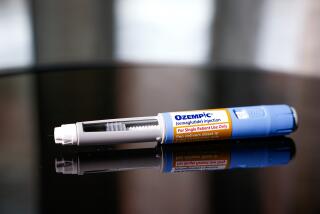When it comes to treating obesity, is fitness more important than fatness?
- Share via
After nearly four decades of rising body weights in the United States and across the world, medical experts are still casting about for the best way to treat obesity and the diseases that come with it.
The answer may depend on which contributes more importantly to ill health: not enough fitness, or too much fatness?
In an essay published this week in the Journal of the American Medical Assn., exercise physiologists suggest that reversing Americans’ couch-potato ways might do more to fight obesity-related diseases than focusing only on weight loss.
University of South Carolina’s Steven N. Blair and his colleagues acknowledge there is a raging debate over whether a person can be both fit and fat. They suggest that more and better research will show the answer is yes.
The problem, they wrote, is that researchers are often so focused on obesity’s effects that they ignore the aerobic fitness of the people in their studies.
Here’s what those researchers miss: When obese people without diabetes, high blood pressure or worrisome cholesterol readings are aerobically fit, they may be no more likely to suffer or die from strokes or heart disease than healthy people with a normal weight.
“These observations should not be interpreted to suggest that obesity should be promoted,” Blair and his colleagues wrote.
But as Americans age, they tend to progressively gain weight and lose fitness, the authors added. And maybe it’s time to focus on the second part of that equation to improve the public’s health.
The essay was part of a special issue of JAMA that focused on obesity. Other take-aways include:
• Among obese patients, those who had weight-loss surgery were about half as likely to die over the next four years than were patients who opted for non-surgical treatment.
• The benefits of “ketogenic diets,” which limit carbohydrates and focus on healthy protein and fats, are promising but preliminary.
• Thanks to the complex interaction of genes and the environment, the prospect of using “precision medicine” to treat obesity lies far in the future — if it exists at all.
• Given the ubiquity of people in the U.S. who are overweight and obese, fewer and fewer Americans even recognize they’re carrying excess weight. And that’s a problem.
Close to 38% of U.S. adults and 17% of American kids are obese. Those figures have more than tripled since 1980.
And it’s set to get worse: One recent study projected that more than half of today’s U.S. kids will be obese by the time they’re 35.
Researchers delving into the science of weight loss have uncovered the myriad ways in which the human body clings to stored fat and angles to restore lost weight. Within five years of having shed extra pounds, 95% of dieters will regain all the weight they lost, and in many case, gain a few extra pounds as well.
And Americans have learned these harsh realities through experience. Despite encouragement, prodding and no small amount of fat-shaming, the proportion of overweight and obese Americans who’ve tried to lose weight in the past 12 months has sunk from 56% in the early 1990s to 49% in recent years.
If you sense that obesity treatments available from doctors are costly, controversial and prone to failure, you’re not alone. Just six short years ago, optimism flourished that progress was being made in preventing and treating obesity, JAMA deputy editor Dr. Edward H. Livingston wrote in an editorial.
“As time has passed, so too has the optimism,” wrote Livingston.
Now, he added, “the approach to the prevention and treatment of obesity needs to be reimagined. The relentless increase in the rate of obesity suggests that the strategies used to date for prevention are simply not working.”
MORE IN SCIENCE
Obese patients lived longer if they had weight loss surgery, study finds
Even without nudging blood pressure up, high-salt diet hobbles the brain
Scientists see evidence of iridescent rainbow feathers on a dinosaur







